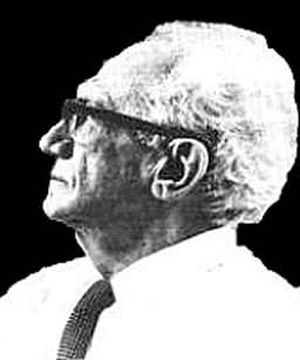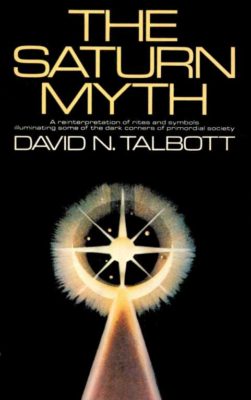This article is about the book. See also: The Saturn Theory
The Saturn Myth (1980) is a book by David Talbott, which proposes that ancient myths and tradition describe the planet Saturn as the the dominant celestial body in the sky, appearing “fixed at the north celestial pole”.[1]David Talbott, “The Polar Sun”, The Saturn Myth (1980) Doubleday, ISBN: 0-385-113376-5 A number of other writers, sometimes called Saturnists[2]C. Leroy Ellenberger, “Still Facing… A Reply to Comments”Kronos Vol. XI No. 1 (Fall 1985), have described similar scenarios,[3]See for example, Immanuel Velikovsky, In the Beginning, unpublished. Online in the the Immanuel Velikovsky Archive. Harold Tresman and B. O’Gheoghan, “The Primordial Light?” (1977) SIS Review Vol. II No. 2. Dwardu Cardona, “Let There be Light”, Kronos Vol. III No. 3 (Spring 1978), see also God Star (2006) Trafford Publishing, 532 pages, ISBN-10: 1412083087. Lynn E. Rose, “Variations on a Theme of Philolaos”, Kronos Vol. V No. 1 (Fall 1979). Ev Cochrane, “The Many Faces of Venus (2001) Aeon Press, ISBN 0-9656229-0-9. which have collectively been described as “The Saturn Theory” (or Saturn Model, or Saturn Thesis).
In his book, Talbott contends that:
“.. the evidence assembled in the following pages indicates that within human memory extraordinary changes in the planetary system occurred: in the earliest age recalled by man the planet Saturn was the most spectacular light in the heavens and its impact on the ancient world overwhelming. In fact Saturn was the one “great god” invoked by all mankind. The first religious symbols were symbols of Saturn, and so pervasive was the planet god’s influence that the ancients knew him as the creator, the king of the world, and Adam, the first man.”[4]Talbott, David N., The Saturn Myth (1980), Doubleday. ISBN 0385113765. “Introduction”.
Basing his evidence on “the language of myth”, Talbott suggests that they support the following elements:
“(1) In the earliest age recalled by man the planet Saturn was the dominant celestial body. .. (2) Accounts of Saturn’s appearance suggest that the planet hung ominously close to the earth. .. (3) The modern age has misread the ancient accounts of “the beginning.” These accounts speak of a creator, a first man, and a first king — all referring to the same cosmic figure. .. The legendary creator, first man, and first king was Saturn. (4) .. massive quantities of cosmic debris exploded from Saturn, clouding the heavens and eventually congealing into a vast band around the planet. .. (5) The ancients drew pictures of Saturn incessantly, and these pictures will be found around the world. .. (6) Images of Saturn in his enclosure occur on every page of ancient texts. .. (9) Receiving light from the solar orb, the Saturnian band acquired a brightly illuminated crescent, which, as the earth rotated on its axis, visually revolved around Saturn each day. .. “[5]Talbott, David N., The Saturn Myth (1980), Doubleday. ISBN 0385113765. “Conclusion”.
Criticism
Milton Zysman notes that:
“The evidence gathered to support this reconstruction is convincing. The author, however, never provides a dynamic cosmographic model to support his arguments, leaving the frustrated reader to supply his own.”[6]Zysman, Milton, Canadian Society for Interdisciplinary Studies Newsletter, (1980) 1 (2), 42-48:
Mainstream reviewers were not impressed:
“Talbott’s complex, mazelike narrative utterly fails to convince.”[7]Publisher’s Weekly, Feb. 1, 1980; p. 78
“Implicit throughout is the naive supposition that the ancients equated the mythological with the celestial, but were not capable of thinking metaphorically.”[8]Library Journal, June 1, 1980, p. 1318.
Talbott “draws on ancient myths and sacred symbols more than on physical data to build his thesis. Scientists are no more likely to accept this cosmic scenario than they did Velikovsky’s planetary collisions….”[9]Robert C. Cowen, “Velikovsky: his theory lives on (unfortunately)“, Christian Science Monitor, Sep 3, 1980, p.16
“Well, if Talbott’s not going to worry about providing a reasonable physical explanation to account for the gyrations he’s requiring of Saturn, then I’m not going to worry about taking his seriously.”[10]Earley, George W. (1981). Fate, August, pp. 108-110.
“Planetarily reconstructed myth in which Saturn is situated at the Earth’s north celestial pole .. seems quite preposterously at odds with gravitation”,[11]Roger Ashton, “The Unworkable Polar Saturn” Aeon I:3 (1988)
“.. it barely needs stating that there are immense problems with the Saturnists’ theory”.[12]Peter J. James, “The Saturn Problem” SIS Chronology & Catastrophism Review 2000:1 “Proceedings of the SIS Silver Jubilee Event”
Contents
- Introduction .. 1
- Myth and Catastrophe .. 2
- The Great Father .. 6
- The “One God” of Archaic Monotheism .. 7
- The Universal Monarch .. 13
- The Age of Kronos .. 14
- The Rites of Kingship .. 20
- The Heavan Man .. 22
- Who Was Adam .. 23
- The Great Father Saturn .. 30
- The Saturn Myth Reconstructed .. 35
- The Polar Sun .. 37
- Sun and Saturn .. 37
- Day and Night .. 40
- Saturn and the Pole .. 42
- The Unmoved Mover .. 45
- Egypt .. 47
- Mesopotamia .. 52
- India .. 54
- China .. 56
- The Americas .. 57
- Sun and Saturn .. 37
- Saturn’s Cosmos.. 60
- The Enclosed Sun .. 61
- The Lost Island
- The Cosmos and the Divine Assembly .. 71
- The Circle of the Gods
- The Great Mother .. 80
- Womb and Thigh .. 85
- Womb and Cosmos .. 87
- The Hermaphrodite .. 88
- The Enclosed Sun .. 61
- The Holy Land .. 90
- The Mother Land .. 91
- Saturn’s Earth .. 91
- The Egyptian Paradise .. 93
- The World Wheel .. 99
- The One-Wheeled Chariot .. 102
- The City of Heaven .. 105
- The Enclosure as Prototype .. 110
- The World Navel .. 113
- The Ocean .. 116
- The Mother Land .. 91
- The Enclosed Sun-Cross .. 120
-
- The Four Rivers of Paradise .. 120
- The Crossroads .. 122
- The Four-eyed or Four-faced God 133
- The Foundation Stone ..134
- The Four Pillars of Heaven .. 138
- Symmetrical Elaborations of the Sun-Cross .. 139
-
- Temple, Crown, Vase, Eye and Circular Serpent .. 145
-
- The Egyptian Temple .. 150
- Temple and Womb .. 151
- The Crown .. 152
- The Vase .. 155
- The Eye .. 158
- The Cirular Serpent .. 163
- In Summary: A Coherent Docrine .. 170
-
- The Cosmic Mountain .. 172
-
- Egypt .. 173
- Mesopotamia .. 185
- India .. 189
- Japan, China, Iran, Siberia .. 191
- Siberia .. 193
- Greece and Rome .. 195
- Western Semitic .. 196
- The Americas .. 199
- A Collective Memory .. 202
- The Mount of Musculine Power .. 205
- The Cosmic Mountain Personified .. 207
- The Single Leg .. 210
- The Serpent/Dragon .. 213
- The Stream of Life .. 217
- The King of the Mountain .. 225
-
- The Crescent .. 228
-
- The Crescent and Saturn .. 230
- The Crescent and Womb .. 237
- Crescent and Motherland .. 238
- The Cresent and Mount .. 240
- The Heavenly Twins .. 245
- Who Were the Dioscuri? .. 246
- The Black and White Twins .. 248
- Symbolism of the Cresent .. 258
- The Crescent-Horn .. 260
- The Horned Mountain .. 265
-
- Ch. 9 Part 2
- The Crescent-Ship .. 269
- The Crescent-Arms .. 282
- The Ka-Arms .. 286
- The Crescent-Wings .. 298
- Interconnected Symbols .. 308
- The Plant of Life .. 309
- Sword .. 312
- The Altar .. 314
- Above and Below, Left and Right .. 315
- Saturn’s Day ., 320
- Conclusion .. 328
- Notes .. 333
- Bibliography .. 385
- Index .. 393
See also
- The Saturn Myth table of contents at Catastrophism.com
- Immanuel Velikovsky, “Letter to David Talbott“, January 29,1975
References
| ↑1 | David Talbott, “The Polar Sun”, The Saturn Myth (1980) Doubleday, ISBN: 0-385-113376-5 |
|---|---|
| ↑2 | C. Leroy Ellenberger, “Still Facing… A Reply to Comments”Kronos Vol. XI No. 1 (Fall 1985) |
| ↑3 | See for example, Immanuel Velikovsky, In the Beginning, unpublished. Online in the the Immanuel Velikovsky Archive. Harold Tresman and B. O’Gheoghan, “The Primordial Light?” (1977) SIS Review Vol. II No. 2. Dwardu Cardona, “Let There be Light”, Kronos Vol. III No. 3 (Spring 1978), see also God Star (2006) Trafford Publishing, 532 pages, ISBN-10: 1412083087. Lynn E. Rose, “Variations on a Theme of Philolaos”, Kronos Vol. V No. 1 (Fall 1979). Ev Cochrane, “The Many Faces of Venus (2001) Aeon Press, ISBN 0-9656229-0-9. |
| ↑4 | Talbott, David N., The Saturn Myth (1980), Doubleday. ISBN 0385113765. “Introduction”. |
| ↑5 | Talbott, David N., The Saturn Myth (1980), Doubleday. ISBN 0385113765. “Conclusion”. |
| ↑6 | Zysman, Milton, Canadian Society for Interdisciplinary Studies Newsletter, (1980) 1 (2), 42-48: |
| ↑7 | Publisher’s Weekly, Feb. 1, 1980; p. 78 |
| ↑8 | Library Journal, June 1, 1980, p. 1318. |
| ↑9 | Robert C. Cowen, “Velikovsky: his theory lives on (unfortunately)“, Christian Science Monitor, Sep 3, 1980, p.16 |
| ↑10 | Earley, George W. (1981). Fate, August, pp. 108-110. |
| ↑11 | Roger Ashton, “The Unworkable Polar Saturn” Aeon I:3 (1988) |
| ↑12 | Peter J. James, “The Saturn Problem” SIS Chronology & Catastrophism Review 2000:1 “Proceedings of the SIS Silver Jubilee Event” |

